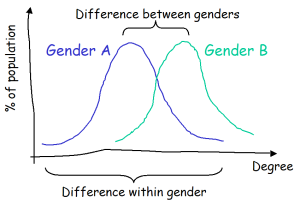I’ve recently been doing a gender course at work. I don’t think it’s because I have been singled out as having gender issues. Perhaps it was just that when people were being nominated, my name was an easy one to say. (I don’t think Lleieusszuieusszesszes Willihiminizisteizzi Hurrizzissteizzi ever had that problem.)
After hearing all about someone else’s view of gender issues, it’s really solidified my own view. I hope I can explain it clearly here. Now, I haven’t experimentally verified this, but it is a testable hypothesis, and seems anecdotally true.
Of all the various personal characteristics, there are those that are directly related to reproduction, and all the rest. For those not related to reproduction (such as height, empathy, strength, ability to multi-task, focus, risk-taking — you get the idea) the characteristics are normally distributed for both genders. This is shown in the following diagram:

The diagram shows how for any particular (non reproduction-based) characteristic, the degree to which it appears in any gender is normally distributed across the population. The conclusion here is that the difference between the genders (as represented by the difference between the average degree of that characteristic for each gender) is less than the difference within a gender (as represented by the spread of degree of that characteristic within any particular gender).
So, treating people in the workplace (or, really any place) as if characteristics that they hold fall anywhere along the spectrum covered by both genders is a good way to ensure that you cover any particular gender well. Certainly, it’s a better approach than relying on characteristics to fall close to the average for a particular gender. In other words, and from the perspective of the male-dominated industry that I’m in, trying to accommodate both men and women is also a good way to ensure that you accommodate a broad spectrum of men.
